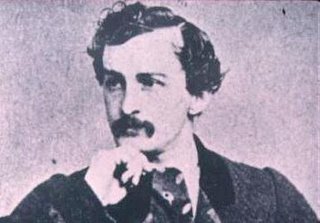CONSPIRACIES IN MONTREAL
DID JOHN W. BOOTH, JAMES E. RAY AND LEE H. OSWALD
ALL CAUGHT THE ASSASSIN VIRUS IN MONTREAL?
PART I: JOHN WILKES BOOTH
"I CANNOT SEE HOW THE CROWN CAN ARGUE
THAT CONSPIRACY TO COMMIT A CRIME IN THE UNITED STATES
IS A CRIME IN CANADA."
Aimé Geoffrion, Sam Bronfman's defence attorney
in a 1935 trial for alcohol smuggling.
Believe it or not, the above argument was given consideration by Judge Jules Desmarais who dismissed the charges against the Bronfman's brothers, Seagram's owners, in one of Canada biggest judicial case, referred to in the press as the "huge liquor conspiracy". Ironically, Seagram's, the company whose founders used this kind of rhetoric, is today one of United States' political parties principal contributors.
The fact that Canada may be used as a safe haven where criminals can’t be prosecuted for planning crimes in the USA, is probably the reason why three of American history biggest political conspiracies had ramifications in Montreal. Those three political crimes being the Abraham Lincoln, John F. Kennedy and Martin Luther King assassinations.
Seventy years before Bronfman’s attorney’s 1935 sophism, Confederate spies had the same line of thought during the Civil War when they used Montreal as one of their sanctuaries. At this time, Confederate intelligence officers used Montreal's St. Lawrence Hall, a prestigious hotel on St. Jacques street, as their headquarter.
History mainly recall how, from there, they plan a raid in Union’s territory to commit a series of bank robberies in St. Albans, Vermont. An act of war, the raid was of an unusual violent nature in a part of the country that was far from the combat zone. In the press, it was commented with critical text such as this:
Montreal Gazette, Tuesday Morning, October 20, 1864
Outrage at St. Albans
St. Albans, Vt., 19th. -- A party of 20 rebel raiders entered this place this p.m. shooting and killing the citizens. They robbed all the banks, stole 15 or 20 horses, killed 4 or 5 and wounded several. They have left town but are expected back soon with a large force. If there is no error or exaggeration in this statement, a gross outrage has been committed, in a peaceful and thriving village, situated on the Vermont Central Railway, a short distance from Rouses Point, and not far from the borders of Canada.
The raiders were able to escape from Vermont and to enter Canada where 13 of the robbers were arrested. Some $80,000 were confiscated from them. Using the same line of thought that Bronfman’s attorney will use years later, Justice Smith of Montreal refused to extradite the Confederate bank robbers. After a short detention, the Confederate criminals were given their liberty ... and even some of their confiscated stolen money back.
Still, in October 1864, a more sinister conspiracy had its root in Montreal St. Lawrence Hall hotel. A this time a famed young American actor made an unusual trip up north to meet with Confederate agents. The actor’s name was John Wilkes Booth and his contacts were the heads of the Secret Service, Jacob Thompson and Clement Clay. Few weeks after those meeting, in mid-November, Booth was back in Washington. Booth carried with him a letter of introduction from the Confederates addressed to Dr. William Queen of Charles County, Maryland. This letter led Booth to meet with Dr. Samuel A. Mudd in November of 1864. With Mudd and others, Booth began putting together an operation to capture Abraham Lincoln and transport him to Richmond. By capturing Lincoln they expected to force the federal government to return Confederate prisoners of war who were confined in Union prisons and then return them to fight Union forces.The attempt to capture the president took place on March 17, 1865. The President, however, changed his plans and luckily escaped the conspirators’ plot only to fall in a deadlier trap. Two weeks later, the long Union siege of the Confederate capital of Richmond, Virginia ended. Then, one week later, on April 9, 1865 General Lee was forced by General Grant to surrender. These Confederate failures apparently gave Booth the incentive to carry out his final fatal plan. Five days after General Lee's surrender, Booth, according to the official version, took the initiative to assassinate Lincoln inside Ford's Theatre. One of Booth accomplices, John H. Surrat escaped to Montreal where he received help to get on a boat to Italy where he enrolled in the Pontifical Zouaves.
Few weeks after those meeting, in mid-November, Booth was back in Washington. Booth carried with him a letter of introduction from the Confederates addressed to Dr. William Queen of Charles County, Maryland. This letter led Booth to meet with Dr. Samuel A. Mudd in November of 1864. With Mudd and others, Booth began putting together an operation to capture Abraham Lincoln and transport him to Richmond. By capturing Lincoln they expected to force the federal government to return Confederate prisoners of war who were confined in Union prisons and then return them to fight Union forces.The attempt to capture the president took place on March 17, 1865. The President, however, changed his plans and luckily escaped the conspirators’ plot only to fall in a deadlier trap. Two weeks later, the long Union siege of the Confederate capital of Richmond, Virginia ended. Then, one week later, on April 9, 1865 General Lee was forced by General Grant to surrender. These Confederate failures apparently gave Booth the incentive to carry out his final fatal plan. Five days after General Lee's surrender, Booth, according to the official version, took the initiative to assassinate Lincoln inside Ford's Theatre. One of Booth accomplices, John H. Surrat escaped to Montreal where he received help to get on a boat to Italy where he enrolled in the Pontifical Zouaves.

0 Comments:
Post a Comment
<< Home